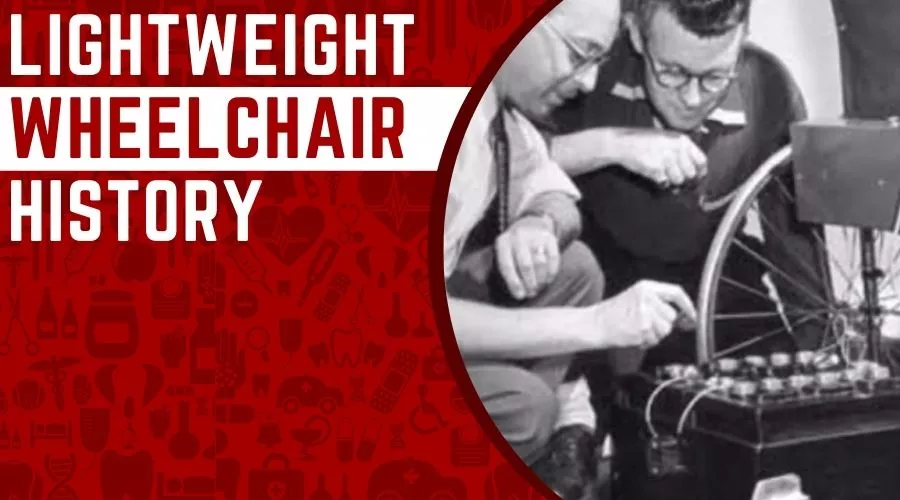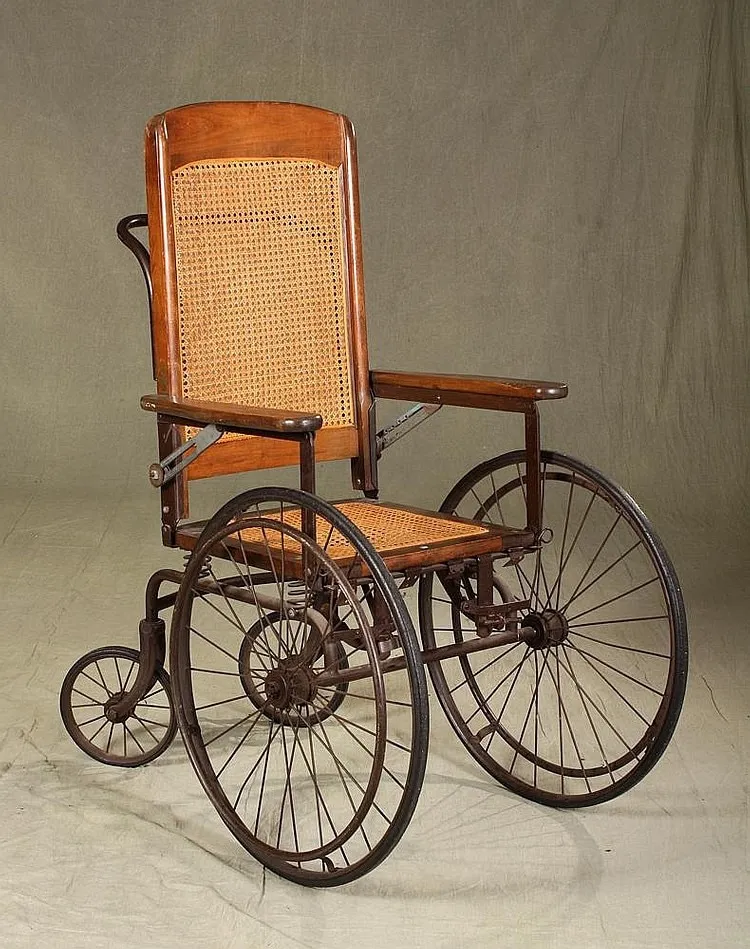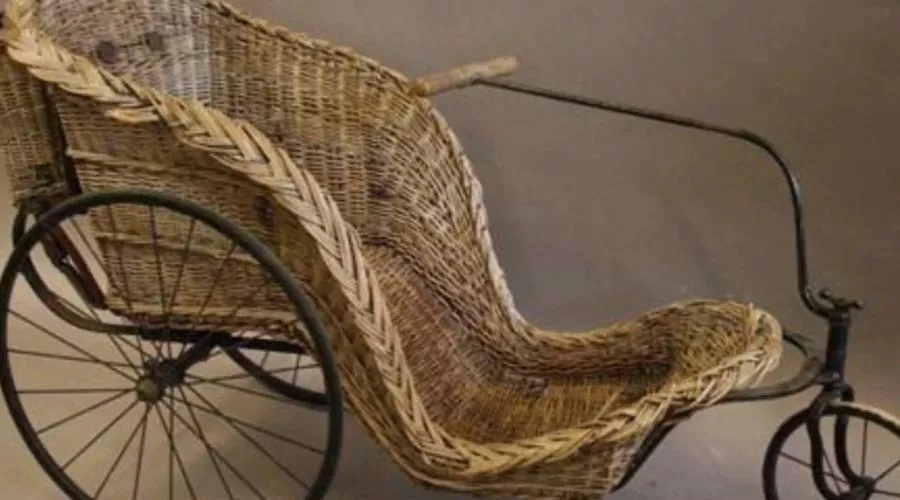
Lightweight Wheelchair: A Revolutionary Breakthrough in Mobility Aid.
From its humble beginnings to the innovative designs of today, the history of the lightweight wheelchair is a testament to human ingenuity and perseverance.
Discover the fascinating evolution of this crucial mobility aid and the impact it has had on people’s lives.
Get ready to be inspired and learn about the advancements in design, technology, and materials that have made today’s lightweight wheelchairs an indispensable tool for those in need of mobility assistance.
Don’t miss out on this fascinating story of progress and empowerment.

In the 15th century, wheelchairs were made from heavy materials like wood and metal, and their design was limited to a simple chair mounted on wheels. These wheelchairs were difficult to maneuver and required significant physical effort to move, making them unsuitable for long-term use.
A lightweight wheelchair is a mobility aid designed for individuals who require assistance in getting around. The term “lightweight” refers to the reduced weight of the chair, which typically ranges from 15 to 25 pounds.
This type of wheelchair is designed to be easily transportable and maneuverable, making it an ideal solution for individuals who need a wheelchair for travel, outdoor activities, or everyday use.

Modern-day Narrow lightweight wheelchairs are engineered with state-of-the-art materials like lightweight metals and high-strength composites. They are designed with ergonomics in mind, featuring adjustable seating and backrests for maximum comfort. The wheels are made from lightweight materials and are designed for quick and easy movement, making them ideal for both indoor and outdoor use. The frames are also designed to fold down for convenient storage and transportation.
I. Importance of Mobility Devices
Mobility devices, such as wheelchairs, have revolutionized the way individuals with physical disabilities move and interact with the world.
These devices have improved the quality of life for many people, enabling them to live more independently and participate in a wider range of activities.
The development of lightweight wheelchairs has been especially significant, as these chairs are much easier to handle and transport than traditional, heavier models.
II. The Dawn of the Wheelchair Era
A. Ancient Times and Early Forms of Mobility Aids
The history of wheelchairs can be traced back to ancient times when individuals used crutches, canes, and other assistive devices for mobility.

In the 17th century, the modern wheelchair was developed for individuals with spinal cord injuries or amputations.
In the 20th century, advancements in materials science, such as the discovery of lightweight aluminum alloys, revolutionized the wheelchair industry and led to the production of lighter, more durable wheelchairs.
B. Emergence of the Wheelchair in the 17th Century

The manual wheelchair is one of the most commonly used mobility devices, and the industry has continued to evolve with the development of new technologies, such as the bath chair, manual wheelchairs, sports wheelchairs, self-propelled wheelchairs, and mobility scooters.
With the rise of these new technologies, wheelchair access has become more widespread, allowing for greater independence for wheelchair users.
III. The Rise of Modern Wheelchair Technology
A. Advancements in Materials Science
The development of lightweight wheelchairs was made possible by advancements in materials science. In the 20th century, the discovery of new lightweight materials, such as aluminum alloys, revolutionized the wheelchair industry.

This led to the production of lighter, more durable wheelchairs that were easier to transport and handle.
Folding wheelchairs, sport wheelchairs, standing wheelchairs, and powered wheelchairs are among the many innovations in the industry, along with the introduction of wheelchair ramps, beach wheelchairs, and standing wheelchairs.
The first self-propelled wheelchair was invented in the early 20th century, and metal rims were attached to the small wheels to make them easier to maneuver.
B. Emergence of Lightweight Aluminium Alloy Wheelchairs
In the mid-20th century, electric wheelchairs were developed, with front and rear wheels powered by an electrical motor.

The introduction of large rear wheels and the use of durable metals like aluminum alloys have allowed modern wheelchairs to be more maneuverable, making them ideal for everyday use.
The overall weight of manual chairs has also been reduced, making it easier for disabled individuals to engage in everyday activities.
The widespread use of aluminum alloys in wheelchair construction was a major breakthrough in the development of lightweight wheelchairs.
Aluminum alloys are strong, lightweight, and corrosion-resistant, making them an ideal material for mobility devices.
With the development of these new materials, manufacturers were able to produce wheelchairs that weighed less than 25 pounds, making them much easier to handle and transport.
IV. The Impact of Disability Rights Movements
A. Increased Awareness of Accessibility Issues
The disability rights movement of the 20th century played a significant role in the development of lightweight wheelchairs.

Activists brought attention to the need for more accessible and user-friendly mobility devices, and the demand for these devices led to increased investment in research and development.
B. The Push for Lighter and More Efficient Mobility Devices
The disability rights movement also played a crucial role in the push for lighter and more efficient mobility devices.
Individuals with disabilities spoke out about the challenges they faced when using heavy, difficult-to-maneuver wheelchairs, and manufacturers responded by developing lighter, more user-friendly wheelchairs.
V. Current Trends in Lightweight Wheelchair Design
A. Innovations in Portability and Durability
In recent years, the trend in lightweight wheelchair design has been toward increased portability and durability.
Manufacturers have developed wheelchairs that can be easily folded and stored, and have added features, such as adjustable seat heights, to make the chairs more comfortable and user-friendly.
B. Advancements in Ergonomics and Comfort
In addition to increased portability and durability, advancements have also been made in the ergonomics and comfort of lightweight wheelchairs.
For example, many lightweight wheelchairs now have adjustable seats, backrests, and armrests, which allow users to customize the chair to fit their individual needs.
Additionally, manufacturers have incorporated new materials, such as foam padding and breathable fabrics, to improve the comfort of the chairs.
VI. Future Prospects of Lightweight Wheelchairs

A. Advancements in Robotics and Artificial Intelligence
In the future, it is likely that advancements in robotics and artificial intelligence will have a significant impact on the design and functionality of lightweight wheelchairs. For example, new technologies may be developed that allow wheelchairs to respond to the needs and movements of the user, making the chairs even easier and more efficient to use.
B. Integration with Wearable Devices and Health Monitoring
Another trend in the development of lightweight wheelchairs is the integration with wearable devices and health monitoring systems. For example, sensors and wearable devices may be integrated into the chair to monitor the health and well-being of the user, or to provide real-time feedback on the chair’s performance and usage.
VII. Conclusion
A.The Continued Relevance of Lightweight Wheelchairs
The development of lightweight wheelchairs has revolutionized the mobility aid industry and has greatly improved the quality of life for many individuals with physical disabilities. As technology continues to advance, it is likely that lightweight wheelchairs will become even more accessible, user-friendly, and efficient.
B. The Importance of Accessible Mobility
All Accessible mobility is crucial for individuals with physical disabilities, as it enables them to participate fully in society and live independent lives. The continued development of lightweight wheelchairs is an important step in ensuring that all individuals have access to the mobility aids they need to live fulfilling lives.
Faqs
What is the history of the Quickie wheelchair?
The Quickie wheelchair was first developed by Sunrise Medical in the late 1970s and was designed to be lightweight and easy to maneuver. This revolutionary design quickly gained popularity and helped to popularize the use of manual wheelchairs for everyday use. The Quickie wheelchair was one of the first wheelchairs to be constructed from lightweight materials, such as aluminum alloys, and it was designed with a strong yet lightweight frame that was easy to transport.
How has the wheelchair changed over time?
Over the centuries, the design of wheelchairs has evolved significantly, with many improvements being made to the materials used, the overall weight, and the ease of use. The first wheelchairs were heavy and difficult to maneuver, but the development of lightweight materials and the introduction of powered wheelchairs have greatly improved the mobility of disabled people. The introduction of beach wheelchairs, bath wheelchairs, and sports wheelchairs has also broadened the range of activities that can be enjoyed by wheelchair users.
Where did the wheelchair originate from?
The history of wheelchairs dates back to ancient times, with the earliest known wheeled mobility device being the invalid chair used by wealthy individuals in Greece and Rome. The modern wheelchair as we know it today was first developed in the 17th century and was primarily used by individuals with spinal cord injuries or amputations. The modern manual wheelchair was invented by an unknown inventor in the early 20th century, and since then many improvements have been made to the materials used, the overall weight, and the ease of use.
What is a three-wheel chassis?
A three-wheel chassis is a type of mobility device that is equipped with three wheels, rather than four. Three-wheel chassis devices, such as beach wheelchairs, are typically lighter and easier to maneuver than traditional wheelchairs, and they are often used in outdoor and recreational settings.






